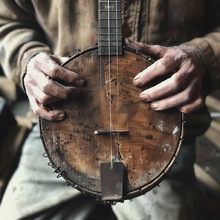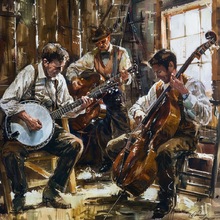Intro to Claw
Striking Finger and Pick Advice
Ok, hopefully you've worked your way through the Lesson Paths for Introduction to Clawhammer and Your First Banjo Chords. If you haven't, check those out! The knowledge gained and skills learned in those will make this lesson series much easier. Try to resist the urge to skip steps. Seeking short cuts will usually just lead to frustration in the long term.
If you have been through those courses, you've gotten used to making the claw shape and using it to strum chords. Another component needed to play melody, and more complicated backup, is the ability to play one string at a time. We'll achieve this by modifying that familiar claw shape in the strumming hand. Form the claw shape. Keep the fingers together, but curl the middle and ring fingers in towards your palm a little more than the index. The index should stick out just a little more than the others. This is your striking finger, which you will use to strike individual strings and also play chords. This is the tool we need to get to the next level of Clawhammer banjo playing. While we recommend you begin your clawhammer journey striking with your index, some people do strike with their middle finger. You may choose to do that at a later time, so check out the video for a demonstration of striking with your middle finger.
Another hugely important part of playing clawhammer is your fingernail or finger pick on your striking finger. While it's possible to play with a very short nail, it is much easier to cleanly strike individual strings and get good tone with a medium length nail - about 1/8th of an inch to 3/16th(about 3-5 cm) on the free edge of the nail should be plenty long enough. File the free edge of the nail to a round or mostly flat nail shape to get a solid tone. Some people have trouble growing long nails, some have trouble with them breaking. That can be due to their daily life or just having kind of brittle nails. Taking biotin can help, but there are other options as well. You can use a clawhammer pick. There are many different kinds. Check out the video and links to see some of our recommendations. Some people don't like picks because you don't get as much tactile feedback and natural feel like you do with a real fingernail. In this case you may look into getting a fake nail. You can get press on nails, but they tend to break easy. It's best to just get it done at a local nail salon. You can get it clear or colored and get them to trim the nail to the length you desire.
Now, let's test out the striking finger by strumming our open G chord. It will feel different than using all 3 fingers in the claw shape. Doing a few strums before we jump into playing single strings will help get you used to that feeling.
In the next lesson, we'll begin playing individual strings.

